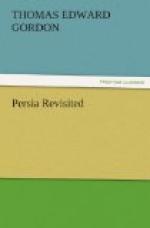The master of the house, who was also headman of the village, explained that the blood-feud had been carried on for five generations, and had originated in a ‘little maid’ who, being betrothed in their village, had eloped with a young man of Aberkoh. The disappointed bridegroom had afterwards taken his successful rival’s life, and the deadly demand of a life for a life had, in accordance with the law of revenge, been made and exacted for the past five generations. He said the elders had hoped the quarrel was nearly dead, as there had been long peace between the parties, but suddenly the hot blood of youth had risen to renew it, and now there was fear of further murder. In that remote district the ancient first principles of natural justice had still strong hold upon the people, and formed, in the absence of established law, the defence of families and communities.
The knowledge that a man is considered disgraced who allows the blood of his father or brother to pass unrevenged makes many a murderer in thought pause, and depart from the deed. Accordingly, in those lawless parts, as a rule, order reigns, and disputes and differences are discussed by the village ‘gray-beards,’ who generally are able to arrange a compromise. But in the reckless rage of a lost love the deed is done, which carries its fatal consequences to future generations, as in the case I have mentioned. I told the old village headman, who was really the local judge, that in some of the wild parts of Firanghistan there were similar occurrences, and that the best form of reconciliation in the present instance would be ‘wife for wife,’ the first offending family giving a girl-love to a husband-lover on the other side, and thus finally closing the quarrel in the happiest manner. I said that under such circumstances intermarriages were generally the best means of improving friendship and terminating feuds between families.
The Tehran street tramways continue to work, though the profit return is small. The company began with graduated fares, but I heard they were considering a minimum general charge, which it was thought would encourage more traffic, especially in the visits of women to one another, as their outdoor dress is unsuited to walking in comfort. The tramway cars have separate compartments for women. The travelling




